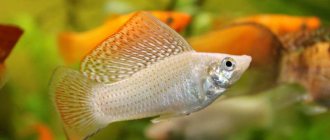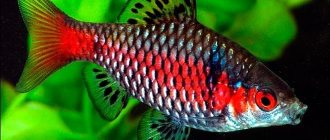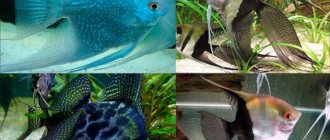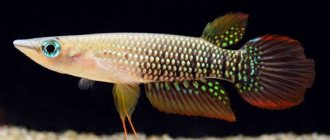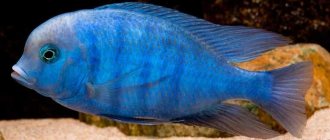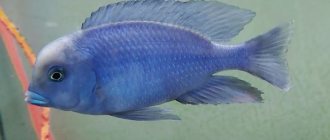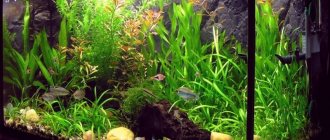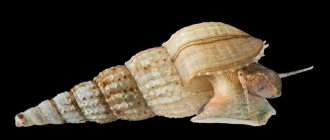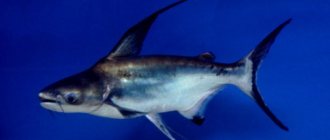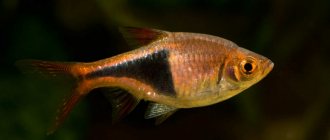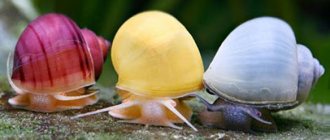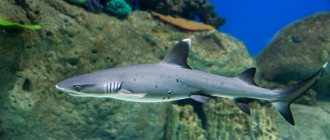Neon blue (Paracheirodon innesi) Myers, 1936.
Synonyms
Russian: Blue neon, Common neon, Neon tetra, Tetra neon Latin: Hyphessobrycon innesi, Cheirodon innesi
Etymology
Paracheirodon: From the Greek para meaning "associated with", and the generic name Cheirodon. innesi: named after the American aquarist, author, photographer, printer and publisher William T. Innes (1874-1969).
Family: Characinaceae Genus: Neons
History of discovery
These small fish owe their appearance in Europe to Auguste Rabaud, who was interested in exotic species of insects (primarily butterflies) and plants (orchids) for the collections of wealthy hobbyists and museums in different countries. He first saw this fish among the Indians when he was sick with fever. Neon floated in a clay vessel standing in the home. Rabo appreciated the find and, upon recovery, began work on transporting the fish to Europe. For a long time he hid the habitat of these luminous fish in order to maintain a monopoly on supplies. He sent several pieces to the famous tropical fish expert William Innes, who at that time was publishing Aquarium magazine in Philadelphia, in the hope that his magazine would create advertising for Rabo. Innes was surprised: it was the first time he had seen such wonderful fish. He immediately sent them for identification to one of the largest ichthyologists in the United States, Professor Myers, who described this species and gave it a specific name.
Feeding
Properly selected food plays a huge role in the life of fish. It should be nutritious, contain all the necessary vitamins and minerals and be in a form that is easy to eat.
Feeding neon
Neons are small fish that prefer the middle and lower layers of the aquarium. Tetra food is ideal for feeding them:
- TetraMin is a classic flake food suitable for all small and medium-sized ornamental fish. Made from more than 40 types of high-quality raw materials, it contains everything necessary for fish, including prebiotics for the proper functioning of the gastrointestinal tract. The flakes float and then slowly sink to the bottom, allowing fish to feed at different levels of the aquarium.
- Tetra Micro Pellets are small, slowly sinking pellets with a size of 0.4-1.2 mm. Ideal for fish with small mouths. The food is completely balanced, perfectly digestible, which reduces water pollution in the aquarium.
Range and Habitat
Neon blue (Paracheirodon innesi) distribution areas
South America: lives both in the tributaries of the Solimões River and in the forest tributaries of the Ucayali, Putumayo, Yarapa rivers (Peruvian part of the Amazon basin).
Neon blue (Paracheirodon innesi) habitat, Putumayo River
Even today, the true extent of its spread remains unclear.
Neon blue (P. innesi) habitats, black water tributaries
These are rivers and small streams with peat bottoms, flowing under a very dense canopy of trees. Light penetrates the water through dense foliage in negligible quantities, creating twilight. Leaves and branches falling into the reservoir, rotting, acidify the water, and a thick layer of silt makes it difficult to wash out and dissolve salts from bottom rocks. Precipitation that falls during the rainy season also replenishes water bodies. Therefore, the water here is exceptionally soft, acidic, transparent and enriched with tannins and humic substances, which give it a brownish tint.
Neon blue (P. innesi) wild trapping sites
The vast majority of fish available in the aquarium trade are commercially produced and are more adaptable than wild specimens.
Diseases
Thanks to their strong immune system, common neons rarely get sick. As practice shows, weakened individuals are mainly susceptible to infection. The most common disease that affects aquarium fish is plistiphorosis.
Symptoms:
- The first thing that catches your eye when a fish gets sick is the dimming and then the disappearance of the distinctive feature of the species - the luminous stripe. After some time, the body color fades.
- Refusal of food. Active movement around the aquarium, throwing around the aquarium, sunken abdomen.
- The body of the individual becomes thin, this is visible to the naked eye. When moving in water, the body tilts unnaturally to the side, and the tail is strongly lowered. It is not easy to return neons to their normal position: such attempts turn out to be failures.
- As a result of being in an uncomfortable position for a long time, curvature of the spine occurs.
- The destruction of the fins begins.
The disease is considered infectious, it is extremely difficult to prevent, and it cannot be treated. The only way out will be to destroy all the individuals in the artificial reservoir, and then it will need to be thoroughly disinfected.
Diseased neon loses its brightness, the fins stick together, and the fish’s behavior becomes uncharacteristic.
Sometimes there is a false neon pathology. The main difference from plistiphorosis is the bacterial causative agent of the infection. A false disease can be cured. A laboratory test will be needed to make a diagnosis. Only after this will treatment be prescribed: for this purpose, it is recommended to add levomycin, kanamycin or biseptol to the water.
Description
Apparently, in order to find each other in almost complete darkness, they have a bright stripe along the entire body, which, when exposed to the glare of the sun, flashes like a neon advertisement, either green or bright blue.
Under this stripe, starting from the middle of the body and to the beginning of the caudal fin, there is another, wider stripe of bright red color.
Size:
The female grows up to 35 mm, the male is usually 30 mm.
Reviews
I really love neon fish: they attract with their exotic beauty. In my aquarium they live in schools of 12 individuals. If you are not going to breed fish, then their gender is not important: males and females are the same in color. Only the females are larger in appearance. I keep the flock in a 25 liter aquarium. In properly created conditions, neons live from 2 to 4 years. My flock is now 3.5 years old. Inga35
Neons are especially attractive when there are at least 10 of them in the aquarium. At high temperatures, bacteria appear in the water, which can become destructive to neons. I try to make sure that the temperature does not exceed 24-25°. I strongly recommend that everyone keep these fish in an aquarium with dense vegetation! This will ensure maximum similarity with the natural habitat. Peter B. 33 years old
Behavior and Compatibility
The fish is peaceful, schooling, active, suitable for keeping in mixed aquariums.
Neon blue (Paracheirodon innesi) large group in an aquarium
It makes the greatest impression in large flocks of 20-30 or more individuals, together with species with similar conditions of detention and similar in size.
Neon blue (Paracheirodon innesi) in a community aquarium
Buy as many as possible from 10 or more, since with this quantity the fish are more active and less shy, more often visible and have better coloring, and exhibit more natural behavior.
Natural enemies of blue neon
Photo: What blue neon looks like
Blue neon is a very friendly fish that usually rarely comes into any conflict with other inhabitants of the reservoir. However, they have one drawback in terms of safety - their bright color. Even in poorly lit areas they are highly visible, making them an obvious target for a hunter. But they easily manage to escape from natural enemies from almost any enemy.
The exception is one of the main enemies - man. The reason is that blue neons in some areas are actively caught for subsequent sale. Against this background, it is the person who is most often called the main enemy of blue neons. But in fact, this is far from the only danger for members of the population.
In addition to people, they are actively hunted by various predatory fish that can live in these same reservoirs. Large predators can swallow whole flocks of neons. But they mainly try to stay in hard-to-reach places where too large a predator simply cannot get. Birds that live near bodies of water and simply catch these bright fish from the water can also pose a danger to blue neon. The same goes for small animals.
If we talk about keeping Blue Neon in an aquarium, then other types of fish may encroach on it. These do not necessarily have to be much larger species. It is enough for members of the population to behave more aggressively. Even when choosing calm fish, you should pay attention to the fact that there are several neons in the aquarium - then they will feel more confident. By the way, it is quite possible to purchase neons of different colors - they match each other perfectly.
Aquarium
Can be of any volume, preferably at least 40 cm in length and 30 cm in height.
Neon blue (Paracheirodon innesi) in aquarium 1
The content is relatively simple. The aquarium must be equipped in accordance with the conditions of the natural reservoirs where they are found. The lighting is moderate, with shadows. The soil is dark (basalt chips, boiled peat) and driftwood, densely planted with plants (Thai fern, cryptocorynes, pinnate, Java moss, etc.), with free places for swimming.
Neon blue diamond (Paracheirodon innesi) in an aquarium
They are unpretentious in terms of water composition, unless subsequent dilution is taken into account, and significant temperature fluctuations must be avoided. Prefers not too hard, slightly acidic water.
Neon blue (Paracheirodon innesi) in aquarium 2
Water parameters:
Temperature: 21 - 28° C pH: 4.0 - 7.5 Hardness: up to 12° dGH
Keep in mind that they, like most fish in this area of South America, can withstand some increase in nitrites and nitrates well, but do not tolerate large amounts of fresh water during water changes! It is better to replace in small portions, but more often.
Adviсe
- Monitor the water parameters - a sharp drop in temperature will lead to pale fish and deterioration in health.
- Provide room for swimming.
- Do not feed only protein foods, because then the fish will refuse any other food.
- Neons do not fight and fight for food, so if competition is high, they will remain hungry. Add more food or move the flock to a separate tank.
Editorial: Pseudoplatistoma tiger
Red neons have become widespread due to their easy care and attractive color. When keeping these fish, every aquarist will receive aesthetic pleasure and closeness with nature.
Previous Fish The mutant barbus is a fish with a unique character Next Fish Black Neons is a beautiful fish with a calm temperament
Nutrition
In nature, it feeds on small invertebrates, crustaceans, filamentous algae, fallen fruits, and the like.
Neon blue (Paracheirodon innesi) nutrition
In aquariums, it can survive on a diet of dry food, but, like most fish, a varied menu is best, which in this case should contain live and frozen food - it should be small enough - the fish has a small mouth.
Fish ailments
Unfortunately, even under optimal conditions, neon babies can get sick. It’s good if the disease turns out to be curable, and the owner is vigilant. Then the fish has a good chance of being saved. But there are also incurable diseases that the owner needs to know about. Here are some diseases of common neons:
In fish with neon disease, the neon stripes begin to fade and disappear.
- Neon disease. This is an incurable fungal infection of the body of the neon fish, from which it quickly dies. If the neon strip has faded and the fish refuses to eat, there is a high probability that the pet is sick. As a rule, in this case the entire aquarium is susceptible to rapid death, and the owner can only liquidate the contents and disinfect the container with soil .
- Dermatocystidiasis. Thin white “worms” – cysts – form on the body of the neon fish. Disputes develop within each entity. Parasites infect fish until vital organs cease to function. The chances of survival are minimal. However, there are cases where the elimination of sick fish helped save the remaining individuals from infection.
- Fin rot. The negligence of the owner is the main cause of this disease. If the water in the aquarium is of consistently poor quality, the fins will begin to decompose. But, fortunately, timely measures save the entire flock, including those who are sick.
Sexual Dimorphism
Sex differences in fish are weakly expressed. Mature females are usually noticeably rounder and slightly larger than males.
Neon blue (P. innesi) male
Neon blue (P. innesi) female
The female has a fuller abdomen and a bent green stripe, while males have a more slender body and a straight stripe. In addition, in males the swim bladder, which is visible through the body, is shifted towards the anus, while in females it is closer to the spine.
Blue neons become sexually mature at 5-8 months.
Natural existence
The schooling neon blue in its natural environment is found in the shaded, highly acidic rivers Putumayo and Ucayali, which are part of the Amazon River basin. The middle layers of the water space and the diversity of insects create comfortable living conditions. A neon stripe along the body serves as a kind of beacon for other members of the pack, showing the location of the owner. Brightness helps in dark conditions.
Breeding
Reproduction requires certain knowledge of hydrochemistry and experience in fish farming. The main condition is careful preparation of producers, spawning grounds and, especially, water.
Adult fish should not be used for breeding purposes. When preparing full-fledged breeders, you should take young individuals 2-3 months old, which are kept in certain conditions. The aquarium is filled with long-aged tap water with the addition of 1/4 part of distilled or pure rainwater. Males and females are kept separately and, regardless of the time of year, are fed live food, excluding the tubifex. It is enough to give daphnia and cyclops, as well as small bloodworms and coretra.
The water in the spawning area should be very soft (0.5-4°) and acidic (pH 5.5-6.5) with a temperature of 22-24° C.
For spawning they are planted either in pairs or in a flock of 5-10 pairs. To do this, it is necessary to select females with the same readiness for spawning. For one pair of producers, 5-6 liters of prepared water can be used.
Neon blue (P. innesi) producers, preparation, breeding
It has been established that acidic water has bacteriostatic properties, that is, it inhibits the development of bacteria. This property is of great practical importance for fish breeding. It is known that in hard water (above 4-5°), the egg shell of many characins becomes impermeable to sperm, and fertilization does not occur. Therefore, it is necessary to artificially prepare water for spawning grounds. It is enough to take 10 liters of distilled water and add 1 liter of tap water. Place the container with soft water in a dark place and let it sit for two weeks. When acidifying water, you cannot use mineral salts, as well as sulfuric, nitric, phosphoric and other acids.
Spawning tank with mesh for Neon Blue
For breeding, all-glass aquariums are used, which must be thoroughly washed and disinfected. At the bottom it is enough to put a separator mesh or lattice and a bunch of Java moss. It is advisable to cover the spawning area with dark green paper on three sides; diffused light should enter it from the fourth. The water in the spawning area should be slightly aerated with small air bubbles.
Neon blue (P. innesi) spawning ground, producers, spawning, breeding
Mature spawners are placed for spawning in the evening. The fish are not fed in the spawning area. Spawning usually begins the next morning. After laying the eggs (within 3-4 hours), the spawners are removed with a disinfected net, and trypaflavin is added to the water until it turns a soft yellow color. The spawning area is completely darkened. During spawning, the female throws out from 100 to 250 eggs. The males are placed in a reserve aquarium. This is done because females collect eggs after 7-10 days for the next spawning, while males are fully ready only after 15-20 days. Consequently, for the next spawning, other, unspawned males are added to the females. 20-24 hours after the end of spawning, larvae hatch from the eggs.
The larvae are equipped with yolk sacs, through which they feed, develop and turn into fry over 5-6 days. From this moment they begin to feed the fry. One half of the aquarium is slightly illuminated so that the fry, gathering in a darkened area, better take food in the illuminated part. They are fed with zooplankton sifted through a thick sieve and mixed with rotifers, which are the best starter food for neon fry.
We must remember that at first the aquarium with fry should not be brightly lit. The darkening is removed only at the moment when the fry are sufficiently strong, i.e. in 12-14 days. This period is the most crucial in raising fry, because... Due to their low motor activity in water, it is necessary to maintain a high density of food organisms. At 14-15 days, the fry can already eat small daphnia and cyclops. During this period, a red stripe appears on their body, and they become similar to their parents. The fry can be transferred to a large aquarium without soil, with water of the same composition and temperature as in the spawning tank. As the juveniles grow, water is added in small portions to the nursery aquarium in which they will be kept in the future (for gradual adaptation to the quality of the aquatic environment). The most negative factor for juveniles is a high level of protein substances and an excessive amount of bacteria in the water.
Neon blue diamond (P. innesi) is an excellent choice for an aquarium
Life expectancy in an aquarium is about 3 years.
Basic content rules
In terms of content, blue neon is unpretentious. Even a small aquarium (at least 10 liters) is suitable for him, which does not need to be covered with a lid or glass: neons are nimble, but not jumping. It is better to purchase a flock of 5-6 or more individuals.
Don’t forget to create a favorable living environment
Basic parameters for comfortable maintenance:
- water - +18-24 degrees. Excessive temperatures can halve the life of fish;
- dH - 5-7;
- pH - 6.5-7;
- lighting is moderate. There must be shaded areas;
- aeration and filtration are required;
- the soil is dark. Against its background, the fish look brighter;
- vegetation - any living plants that do not interfere with the fish’s free swimming;
- decorations - mounds of stones, decorative grottoes, caves, castles, snags.
Notes
One of the most popular and recognizable fish in the aquarium hobby, this variety has been selectively bred into a number of additional forms, including albino, "golden", short-bodied, veil and "diamond" (which have shiny scales on the back).
Tetra neon Golden diamond veil (P. innesi) selection form
Unfortunately, years of commercial breeding have somewhat affected the genetic strength of the ornamental strain, meaning that morphological defects and poor health are widespread.
The most common disease is plystophorosis. In sick fish, the color fades, the brightness of the neon strip disappears, and coordination of movements is impaired: they hold their tail down at an angle of 45-60°. Trying to get out of this position, they make jerky upward movements. They stop taking food. Treatment for the disease has not been developed. If it occurs, fish, plants, snails must be destroyed, the aquarium, nets must be disinfected, and the soil must be calcined or boiled.
identification:
Coloration is perhaps the most convenient method of identification for aquarists; differences in the color structure of P. innesi can be distinguished from its relatives Red Neon (P. axelrodi) and Green Neon (P. simulans).
P. innesi differs from P. axelrodi in that it has relatively less red pigment on the body, a narrower blue lateral stripe, and a more distinct white line on the anal fin.
Green neon (P. simulans) similar species
It is distinguished from P. simulans by having a bluer (versus greener) lateral stripe that extends only to the adipose fin (versus the base of the caudal fin), more red pigment on the sides, and a more distinct white marking on the anal fin.
Health
Neons have the ability to lose their brightness during the night. This makes them less accessible to predators. But if the color disappears during the daytime, this may mean that the fish is sick.
The reasons that can affect the health of individuals can be different:
- insufficient oxygen;
- improper feeding (usually overfeeding);
- water temperature (below 15-16 C°);
- water pollution;
- pathogens.
Neons most often suffer from the following diseases:
Plistiphorosis
This is the most common disease that kills neon fish. Its second name is “neon disease”. The fungus affects the muscles. The first symptom is a pale color and neon stripe. As the disease progresses, the fish becomes completely discolored and swims on its side or upside down. Then he dies. The disease is contagious, so the sick individual must be quarantined or killed. There is no treatment.
Saprolegniosis
The causative agent is also a fungus. The main causes of infection are poor aquarium hygiene, unbalanced nutrition and overcrowding. You can notice that the fish is sick by a spore-like coating and gluing of the fins.
False neon disease
The disease received its name due to the common symptoms with plistiphorosis. Only the causative agent is the bacterium Nocardia asteroides. The neon fades, the bright stripe disappears, and a whitish coating appears over the entire surface.
Lifespan
How long a neon fish will live depends directly on the water temperature. Thus, at temperatures above + 26 °C, fish quickly age and live no more than 1.5 years. Therefore, it is better to keep them in water at 20-24 C°. Then their life expectancy will double or triple, that is, the neon will be able to live 3-5 years.
Mr. Tail recommends: varieties
There are many types of Neons, let's consider their distinctive features sequentially from the most common to the rarest.
Blue Neons
Paracheirodon innesi is the most popular variety in the aquarium hobby, usually called the Common Neon. A shining turquoise stripe runs along the entire length of the silver body, the lower part of the body is bright red, the back is grayish-brown, and the fin plumage is transparent. Females are slightly larger than males and reach a length of 4 cm. In addition, males are more graceful than females and their lateral line is straight and even, their fins have a ruby tint.
Reproduction in captivity is possible subject to a number of conditions, the main of which are dim lighting and peace. The same parameters are necessary for raising juveniles.
The homeland of the species is slow-flowing rivers and streams of South America, shallow and middle layers. Individuals raised on farms in Eastern Europe and the Far East end up in home aquariums.
Red Neons
Paracheirodon axelrodi is also a very popular and widespread aquarium species, found in nature mostly in the Rio Negro and Orinoco and actively commercially produced artificially on fish farms in Europe and the Far East.
A small omnivorous fish grows up to 4-5 cm (females are slightly larger in thickness during spawning). The color is dominated by two colors - blue and ruby, located along the body in wide stripes. The scales are highly reflective, so a bright school of fish sparkles and shimmers with a neon glow in the rays of light.
A difficult fish to breed, sexual dimorphism is very weak, low compatibility in pairs and limited indicators of acidity and water hardness for successful fertilization of eggs. The larvae are born extremely small and difficult to feed and nurture.
Black Neons
Hyphessobrycon herbertaxelrodi is very beautiful and energetic; the species was first described only in 1961. The homeland of the fish is the slow-moving reservoirs of Brazil, Bolivia, and Paraguay. They live primarily in highly acidic environments, and the shallow waters where schools of Black Neons live are dark in color due to the abundance of fallen leaves and other organic waste.
The body of the fish (they grow up to 4 cm) is painted graphite or dark silver, with two parallel stripes of snow and coal colors running along it. The white one has such a high reflectivity that in bright light a school of fish resembles neon sparks.
If all requirements for the parameters of the spawning tank are met, successful breeding at home is possible.
Golden Neons
They belong to the artificial selection species of Ordinary (Blue) Neon Paracheirodon innesi. Differs from the wild ancestor by golden markers in color.
Looks good in an artificial pond in a large flock (about 30 individuals).
Turquoise or False Blue Neons
Paracheirodon simulans is widespread in the waters of South America. This is a small (2 cm) and very bright fish, not inferior in expressiveness to true Blue Neon.
The red stripe is not so bright, blue tones predominate.
Actually, this variety is called a false species only because it was discovered later by Paracheirodon innesi.
Breeding in aquariums is quite simple, provided that the parameters of the aquatic environment are observed and there is good darkness, because in nature the fish lives in dimly lit reservoirs with dark water under dense tree crowns.
Green Neons (Costello)
Hemigrammus hyanuary Durbin is found in nature primarily in the Amazon, as well as in the Brazilian Lake January.
The maximum length of females is about 4 cm, males are slimmer and more graceful. The color is dominated by greenish and olive tones, with a bright turquoise neon stripe running down the middle of the body.
Under natural conditions, a pair lays up to 300 eggs during spawning. In an aquarium, reproduction is problematic due to poor compatibility of individuals and the difficulty of recreating natural environmental parameters.
Tricolor Neons (Heterorabdus)
Or Trilinear tetras Hyphessobrycon heterorhabdus are mostly distributed in the reservoirs of the Brazilian states of Pará and Maranhao - the Tocantins and Xingu rivers.
The fish is small (up to 3 cm), the back is dark gray, and the belly is silver. A longitudinal stripe of three colors stretches across the entire body (black, yellow, red), reminiscent of the Belgian flag in color, which is why the pet is sometimes called the Belgian flag.
Comes from South America from the eastern states of Brazil - Pará and Maranhão. Inhabits the basins of the Tocantins and Xingu rivers, as well as many other rivers flowing down the eastern Brazilian coast into the Atlantic Ocean. It is found in small streams flowing among tropical rainforests. The natural habitat is not subject to seasonal changes, as happens in the Amazon (rainy and dry seasons). The riverbed is shaded by tree crowns and riparian vegetation. The water is clean, transparent, the substrates are sandy, the bottom is covered with a layer of fallen branches and leaves. Aquatic plants are usually absent.
Platinum Neons
Hemigrammus rodwayi or Golden Tetras have scales with a golden tint, hence their name.
The golden color of the cover of a small (4 cm) but bright fish is given by guanine located under the skin; it protects individuals from the effects of parasitic organisms.
The species' homeland is Guyana, Suriname, French Guiana, and is mainly found in floodplains and coastal areas, at the junction of fresh and salt waters.
They reproduce easily in home aquariums, but the unique natural coloring is not preserved; the fish turns silver.
The caudal fin has a dark marker, the fin feathers are also golden with white edging and ruby rays
Peruvian Neons (Hifessobricon Loreto)
Hyphessobrycon loretoensis is found naturally in Peruvian reservoirs in the northeast, in the state of Loreto, and the species bears its name.
This species is unpretentious to the conditions of detention, easily reproduces in captivity, and gets along well with any peaceful underwater inhabitants.
A very small fish, reaching a length of 2 cm with mild sexual differences. The body is grayish-silver with a dark longitudinal stripe and a bright golden neon streak. There is a red spot at the base of the tail.
Belkey Neons
This species of Neons Boehlkea fredcochui Gery is also called Blue Tetras. In nature, they are usually found in the habitats of the Peruvian variety and are supplied together. Named in honor of the ichthyologist James Behlke, who first isolated and described these fish.
Silver body with a neon blue tint, maximum size 5 cm. These fish are difficult to breed at home.
Lilac Neons Kerry
Inpaichthys kerri are miniature (maximum 3.5 cm), peaceful, unassuming and easy to breed.
In nature, they are found in the upper part of the Amazon, in its largest tributary Madera, in canals and forest tropical streams.
The main body color is bluish, with purple neon reflections, and a dark stripe stretches along the body. Bright males, females usually in brownish and yellowish tones.
African Golden Neons (Nannaphiops unistratum)
Nannaethiops unitaeniatus are rarely found in amateur aquariums, although they have an outstanding color, calm character and are quite unpretentious. Breeding is possible if the requirements for the spawning ground and parameters of the aquatic environment are met.
The homeland of the species is the Congo and Niger rivers, flowing in Cameroon, Nigeria, Gabon, Democratic Republic of the Congo, lakes and ponds, streams.
The main background is bluish, two longitudinal lines on the body are golden and blue with neon reflections. The female is much larger than the male and grows up to 5-7 cm, the male is about 4.5 cm. During the mating season, ruby tones predominate in their color.
Neons Erythrosonus
Hemigrammus erythrozonus was discovered by scientist Durbin in 1909, found for the first time in the Essequibo River (Guyana).
The firefly is so named because of the bright neon and orange stripe that runs along its entire body. The main color is almost completely transparent.
Palmer's Nematobrikon Neons
Hemigrammus ocellifer is a widespread tropical lanternfish. This pet is easy to keep and breed.
Natural habitat is slow rivers and streams flowing in Guyana, Suriname, French Guiana, Peru, Brazil. Wild specimens are not currently caught; individuals are bred for commercial purposes on fish farms in Eastern Europe.
The maximum length is 4-5 cm. The body is silvery, the fin plumage is translucent. There are red markers near the eyes. A pale yellowish stripe with a neon sheen runs along the body.
Sexual differences are weakly expressed; the female becomes more rounded only during spawning.
Savannah Neons
Hyphessobrycon stegemanni are favorite pets of any aquarium.
Inhabitant of the savannah regions of South America, mainly the Cerrado, the Tocantins River basin (states of Tocantins and Maranhão). Considered an endemic species.
At the moment, the natural population of these Neons has been greatly reduced as a result of the destruction of savannah forests.
The maximum size of the fish is 3-3.5 cm. The main background is grayish, with a dark line running along the body. In reflected light, the scales shine and shimmer with neon flashes.
There is virtually no sexual dimorphism and it is difficult to reproduce in captivity.
Blue-Eyed Neons
Or Pseudomugil cyanodorsalis. A common aquarium pet that can be kept in both freshwater and marine tanks. The fish are unpretentious and easy to keep and breed.
The maximum body size is 3-4 cm. The color is yellowish-blue, the back is azure with a neon sheen. The plumage is long, resembling a skirt when raised. Males are brighter and slightly larger than females.
In nature, they live on the Australian continent (north and northwest), in New Guinea. They inhabit river deltas flowing into the ocean, coastal lagoons, mangrove swamps, and occupy the edge of the sea. They can withstand fairly high concentrations of salt in an aquatic environment.
